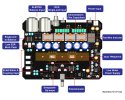Are there not two different measurements in discussion here? SINAD vs THD up to 5 watts where most of the power is relevant anyway?
It's a question of whether the THD is audible, or thresholds of THD audibility surely? I'm sure power matters though, just how much vs speaker sensitivity.
What is interesting about the 3251 model is the 'over engineering' aspect with PBTL - it gives more current possibly for those lower impedance loads, while not delivering extra watts, which may or may not be necessary.
It's a question of whether the THD is audible, or thresholds of THD audibility surely? I'm sure power matters though, just how much vs speaker sensitivity.
What is interesting about the 3251 model is the 'over engineering' aspect with PBTL - it gives more current possibly for those lower impedance loads, while not delivering extra watts, which may or may not be necessary.







